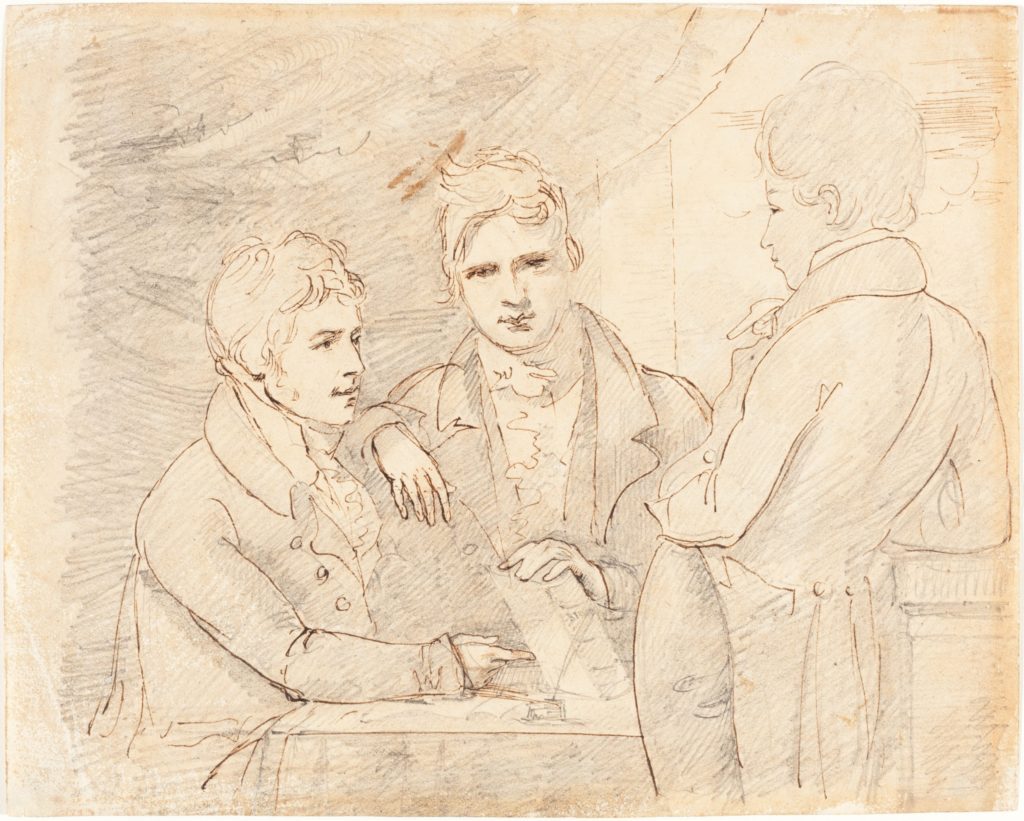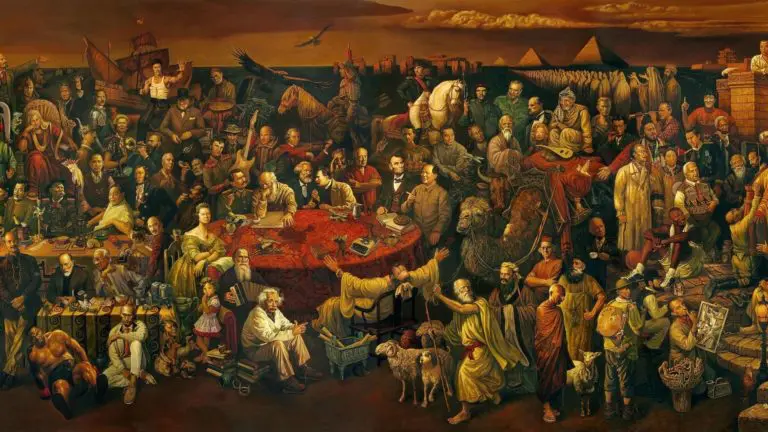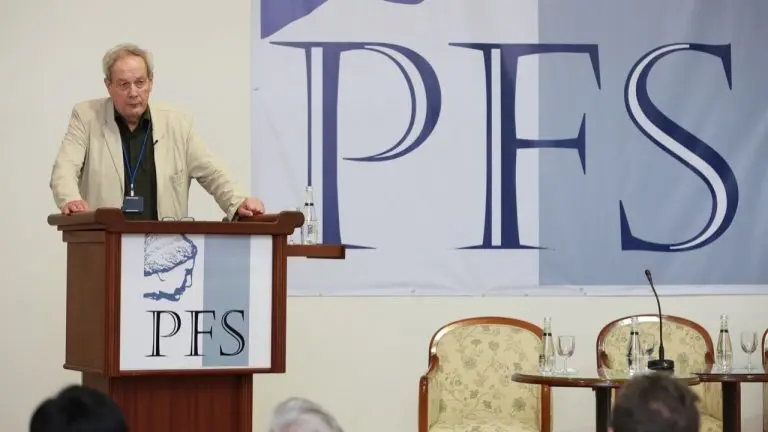One of the dominant acronyms in the teeming morass of contemporary internet lingo is LARPing—or “Live Action Role Playing.” Originally a term for the sport of early millennials and late Gen Xers who would dress up in medieval costumes and engage in semi-serious combat in parks and fields throughout Europe and the U.S., LARPing is now used to describe any self-presentation (either insincere or authentic), whether in the digital realm or in the real world.
One group that is pilloried (with varying degrees of justification) for LARPing is the “Young Fogeys.” First applied to conservative English intellectuals and writers of the 1970s and 1980s—such as architectural historian John Martin Robinson and The Daily Telegraph’s John Casey—the term has recently been revived to describe the style and manner of internet figures such as Andrew Cusack, as well as a small but well curated fleet of blogs covering everything from Napoleonic warfare, to vintage jackets (twee, of course), to videos about eccentric, wealthy, young Frenchmen who are remodeling recently purchased castles.
The Young Fogey is, in essence, a man or woman who refuses to acquiesce to the vulgarity of the postmodern world, preferring the fashions, food, and even faith of previous generations. Because of their gentlemanly manner and seemingly oddball habits, Young Fogeys are especially prime targets for unmannered but equally oddball internet personalities.
While this jesting and ridicule can be cruel, it is, nonetheless, perhaps rooted in a genuine hunch that much of what Young Fogeys do and say can be insincere. In short, there is a suspicion that the argyle socks and Instagram posts of Oxford courtyards—and even the triumphant Tweets boasting of incensed traditional Latin Masses—may simply be for show and attendant social media “likes” and “retweets.”
But Young Fogeydom is not a new phenomenon in the Anglophone world. Indeed, Young Fogeys may have made their first appearance at Oxford University during the Tractarian Movement of the mid-19th century.
Although they actually wore Victorian dress during the Victorian period, the first class of Young Fogeys, the Tractarians, were as obsessed with making the past present as their 20th and 21st century successors. However, although there were some who were more obsessed with (neo-)Gothic architecture and ornate liturgical vestments than with the actual content of Christian teaching, the Tractarian movement—at least as envisioned by its major figures such as John Henry Cardinal Newman—represented a sincere search among Anglicans for the authentic Catholic Church.

In his 1848 novel Loss and Gain, Cardinal Newman presents a fictionalized account of his own conversion to Catholicism through the story of “Charles Reding,” a young student at Oxford University who leaves Anglicanism for the Catholic Church. (Despite Newman’s protests to the contrary, there are a number of seemingly parallels between Reding’s life and his own.)
Unlike many other English (and French and Russian) works of the 19th century, Loss and Gain does not present rich and vibrant characters like Victor Hugo’s Jean Valjean, Dickens’ Pip, or Dostoevsky’s Raskolnikov; nor is Loss and Gain a work about the beauty and majesty of the European city or the English landscape. Rather, Loss and Gain is a book about ideas; more specifically, it is a book about the deepest and most human ideas.
The book often reads like a variation on the great late Medieval morality play, Everyman—or even, in a certain sense, like a Platonic dialogue. Through a thicket of conversations (accompanied by tea and scones), the main protagonist, Charles, parries the objections of peers and teachers to explain why he has chosen to abandon the Thames for the Tiber.
Despite its (moderate) age, as well as its lack of pathos and vibrant aesthetic architecture, Loss and Gain is a work especially apropos for our age in which a large swath of the population, whether Young Fogey or not, is concerned with appearance at the expense of authenticity.
Early in the novel, Newman writes of his youthful contemporaries who lack any firm intellectual grounding:
They do not know what happened ten years ago, much less the annals of a century; the past does not live to them in the present; they do not understand the worth of contested points; names have no associations for them, and persons kindle no recollections. They hear of men, and things, and projects, and struggles, and principles; but everything comes and goes like the wind, nothing makes an impression, nothing penetrates, nothing has its place in their minds. They locate nothing: they have no system. They hear and they forget; or they just recollect what they have once heard, they can’t tell where. Thus they have no consistency in their arguments; that is, they argue one way today, and not exactly the other way tomorrow, but indirectly the other way, at random.
Such a description would be entirely fitting for the contemporary citizen of world whose politics vacillate year by year—from the “Bernie Bro” to the darkest corners of the Alt-Right—and whose religious beliefs are a hodge-podge of Christianity, Hinduism, Buddhism, stoicism, and nihilism, all shakily undergirded by a self-conscious and ironic Luddism.
This description is not meant to be the griping of an aging late Gen Xer overwhelmed by the new digital frontier; it is meant to note that the problem of lacking foundations, and the search for intellectual and spiritual stability, is nothing new.
This lack of intellectual and spiritual stability is something that Newman encountered at Oxford—and was something he battled against his entire life as a Catholic Cardinal. However, as Newman notes in Loss and Gain, the solution to the confusing blend of systems and ideas that has overwhelmed the modern Westerner since the invention of moveable type is not merely intellectual conversion. It is, rather, a gift of faith—and this gift of faith is something only God can give.
Towards the end of Newman’s novel, the character Willis, who converts to Catholicism before Charles Reding, tells his seemingly wavering friend Charles of the importance of faith:
Oh, my dear friend, quench not God’s grace; listen to His call; you have had what others have not. What you want is faith. I suspect you have quite proof enough; enough to be converted on. But faith is a gift; pray for that great gift, without which you cannot come to the Church.
This faith and grace is something that ultimately comes from a God who, as St. Augustine wrote in his Confessions (during a time of intellectual and spiritual turmoil in the late Roman Empire), is a beauty “ever ancient, ever new.”
There is nothing passé about God and the strength of authentic faith—even in our “post-ironic,” “postmillennial,” and “post-postmodern” age in which tiredness and boredom are the default existential states for many people. The impulse among many conservatives—whether or not they are Young Fogeys—to find a response to this tiredness and boredom through ornamentation and the fancy dress of the past springs from a noble desire.
However, the appearances and ideas of the past must be grounded in something real. And in this year marking the 700th year of Dante’s death, it may be worth recalling the poet’s words that there is nothing more real and permanent than the “Love that moves the sun and the other stars” (Paradiso).






